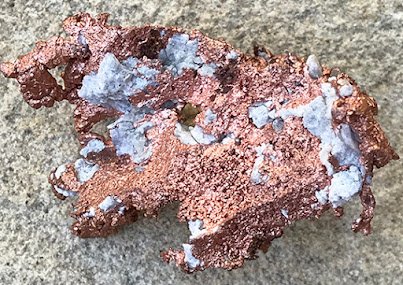Copper (Cu) is one of the first metals used by humans. Copper is one of the few metallic elements to occur in native (pure) form. The white mineral in the example below is probably quartz. Native copper has a Mohs Hardness of 2.5–3.
Specimens of arborescent massive native copper like the hand specimen shown above (5 cm in length) are moderately common in the Moreno area of Greenland County, Arizona.
Malachite Cu2(CO3)(OH)2 and azurite Cu3(CO3)(OH)2 are very similar minerals containing copper (Cu). Malachite is a rich shade of green, and azurite is a dark shade of blue. Both are secondary copper minerals, and they occur worldwide commonly in the upper oxidized zone of copper deposits, especially where limestone is present. Both minerals are almost always associated with each other, and they are found commonly in open-pit mines of copper. Malachite is used in making jewelry.
Hand specimens of malachite (on the left) and azurite (both as massive forms). Each specimen is about 40 mm in height.
Additional comments about malachite: this mineral has been extensively mined, dating back at least 3,000 years, at Tima, southern Israel. Extensive archaeological research has shown this locality to most likely be the so-called “King Solomon Mines” locality, which has been inaccurately depicted in several movies as a non-descript locality “deep in the jungles of Africa.” Perhaps the most famous of these movies is the 1950 one, starring Stewart Granger. There is a classic scene where there is a pile of riches: “rubies, emeralds, diamonds, and gold,” but, alas, malachite and azurite were not included.
Chrysocolla (CuSiO2-2H20) (pronounced “cris-o-cola”) is a copper silicate mineral with a high copper content. Its color is blue-green (cyan), or brown to black. It is a “secondary” mineral that forms in the oxidation zone of copper deposits when free silica (Si) is available. One of the distinguishing characters of chalcopyrite is that it will readily “stick” to a wet finger. That is how many beginning-geology students, taking a class in mineralogy, identify this mineral. Chrysocolla is commonly found associated with malachite and azurite. Like malachite, chrysocolla has been used in making jewelry. Chrysocolla has a wide range (2.5 to 7) of hardness on the Mohs Scale (see one of my previous blog posts).
The hand specimen of chrysocolla (massive form) shown above is 13 cm in longest dimension.













